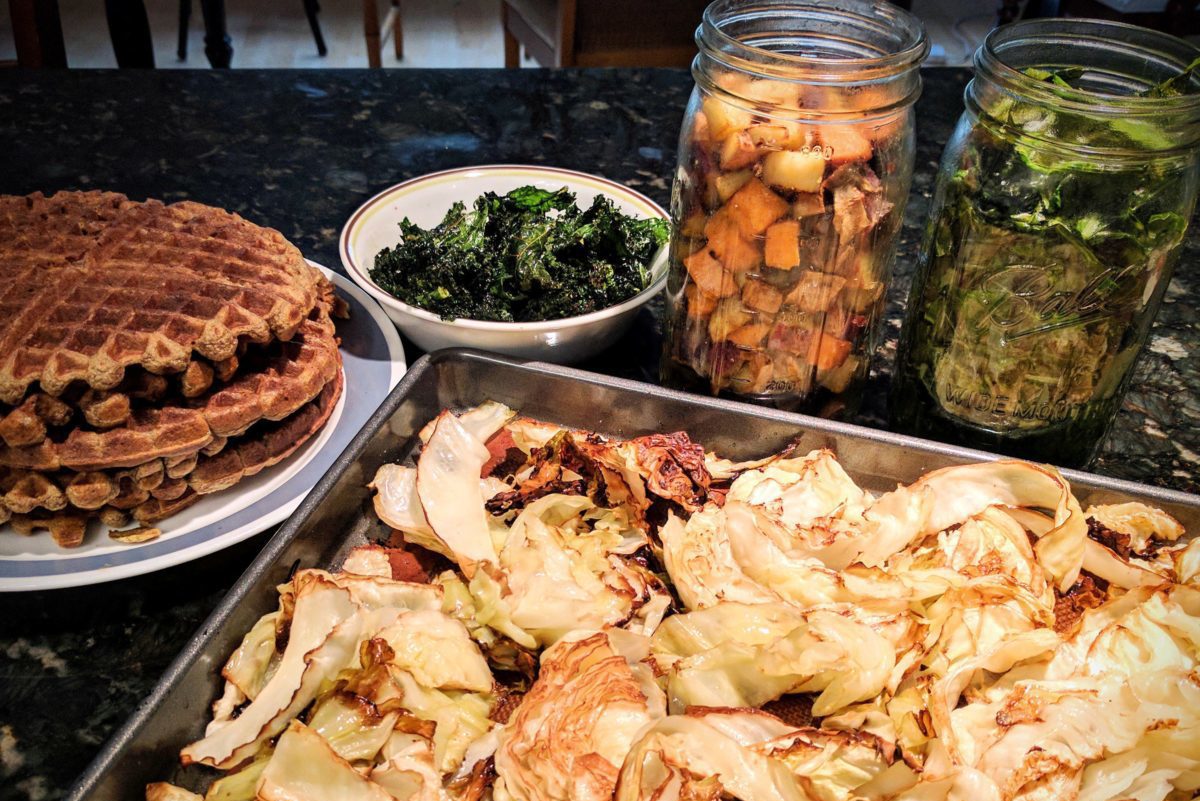20 tips for starting the AIP! I often hear the question “how do I start the AIP (Auto-Immune Protocol)?” Dramatically changing up your diet and lifestyle can be daunting, that’s for sure. So, as requested, here are my favorite tips.
First, the food part:
1) BABY STEPS ARE OK!
If completely revamping your diet in one day seems overwhelming, you are not alone. Do what you can. Think about eliminating foods in two-week increments, if that’s easier than going whole hog. For example:
Removing all gluten (wheat, barley, rye) from your diet – and your house – is a great start. Remember that gluten should never be reintroduced for those of us with autoimmune disorders as it only perpetuates a leaky gut.
Until the science changes surrounding gliadin and zonulin (check out Dr. Alessio Fasano’s research on all of this if you are curious), it’s best to eliminate it from your diet forever. Getting it out of the house will mean you will not be tempted while at home.
Next, work on removing all processed foods. This will eliminate a lot chemicals/preservatives (which our bodies don’t process well) and sugars. It will also help you get into the habit of reading those labels. If you do buy prepared foods, go for the least number of ingredients as possible.
Refined oils can also be eliminated here. These would be corn, soy, canola, sunflower, and safflower oils. My gut does not like these oils, so I avoid them like the plague. Good info here on why these “industrial seed oils” are not good for us.
Dairy is next. For those of us with Hashimoto’s and thyroid issues, this one should be removed from one’s diet forever along with gluten as it can act like gluten in the body, creating antibodies that specifically target the thyroid tissue (ghee is one dairy product that some do ok with when reintroducing as *most* of the casein is removed). Remember it’s the casein, not the lactose that I’m talking about here. That said, many people are intolerant to lactose as well, and removing lactose may even improve thyroid lab levels.
Speaking of dairy, A2 casein may be fine for some people (most milk contains A1 casein). Sheep, goat, camel, and some cow’s milk have mostly A2 casein and may be easier to digest. Can those of us with autoimmune disease, particularly Hashimoto’s, tolerate this type of dairy? More studies are needed on this topic (here’s one), but something to play around with if you are curious.
Caffeine and alcohol can really mess with our cortisol levels and circadian rhythm, so those would be next on my list to eliminate. Or at least cut back on.
Soy in all forms can be an endocrine disruptor. Soybeans are also legumes, which can be highly inflammatory for some. Cutting back or eliminating soy early on may be wise if you currently are eating a lot of soy products.
If you experience stiff/painful joints, consider removing nightshades. Plants in the nightshade family include tomatoes, peppers, eggplant, and white potatoes (not sweet potatoes or yams – they are a different family and have different chemicals). Ashwagandha is also a nightshade, so be wary of this herb if you suspect nightshades causing inflammation.
If you’ve made this far and feel great, then you may not have to go further! Lucky you. But many find that removing other potentially inflammatory foods (eggs, nuts/seeds, all legumes, all grains including oats, corn and rice, etc.) is necessary to find relief from symptoms.
And don’t forget: The AIP is not just about eliminating foods, it’s about eating nutrient-dense foods. More on that later.
2) REMOVE NON-AIP FOODS FROM YOUR HOUSE.
This may seem obvious, but for many, they just can’t bear to throw out that container of nuts or chocolate bar. As mentioned above, getting it out of the house will mean you will not be tempted while at home. In this case, I suggest giving away your non-compliant food to family and neighbors. Unopened packages and cans can always be donated to local food pantries, as well. A win-win situation!
Flours, starches, non-GF baking powder, refined oils, nut/seed-based spices etc should be removed from the kitchen. Note: Spices I held on to, as many seed-based spices (that can be expensive) can be reintroduced for many. I threw them up on a top shelf so I was reminded to not use them. I tossed all of my refined oils (canola, vegetable, corn, soybean, sunflower, etc) as they can get rancid pretty quickly, but, best to avoid them anyways in the long run (see article linked above in #1 as to why). Out they went!
If you have non-perishables that may be treated as reintroductions (say a really special bar of chocolate, coffee that you love, etc), perhaps give these to a neighbor for “safekeeping” (if you trust your neighbor, lol). Just get them *out* of the house. The temptation is real, don’t toy with it!
3) PRINT OUT FOOD LISTS and PLAN, PLAN, PLAN.
Get into the habit of making a meal plan every week. Once you get into a rhythm of shopping, prepping, and cooking, this will become much easier. But to start, sit down once a week and really *think* about every single meal and snack, and buy those items and stick to the plan. How much do you need for yourself – and your family (if they are also going to follow the diet portion of the AIP)? What about snacks? And beverages? What do you usually eat for breakfast? What could you eat instead?
Tip within a tip: leftovers from the previous night’s dinner are often a quick and easy breakfast.
Write it ALL down, and get organized. Clear your head, get it down on paper (computer, phone, what have you).
If you haven’t already, print out my AIP quick-and-easy food list. There are many, many detailed food lists out there (and each of them ever-so-slightly different, of course), but this list is super basic and will get you off on the right foot.
Also, plan when you are going grocery shopping, and make this a priority. Put it in your schedule. Keep track of sales your grocery store is having and stock up on your favorites.
Some other thoughts to consider when planning:
If you have the means, then definitely go organic. If you are unable to eat organic all the time, the Environmental Working Group’s (EWG) “Dirty Dozen” and “Clean Fifteen” lists are good resources to see what fruits and veggies are the most pesticide-laden and pesticide-free.
Your plate should be 75% veggies and 25% animal protein, fruit, and fat. So don’t go crazy thinking you have to spend all of this money on grass-fed meat. Think veggies. Eat the rainbow. As far as meat, don’t forget that organ meats (offal) are not only some of the most nutrient-dense foods you can eat, but they are also some of the least expensive. Chicken livers are cheap and tasty – these I buy at Whole Foods, salt, and fry up in bacon fat. Serve over salad greens with orange or grapefruit wedges and an oil and vinegar dressing. Easy simple salad.
Plan to always have food on hand. This will get easier as time goes on, as well. You’ll have a fully stocked AIP pantry with AIP snacks that will get you through an “AIP Emergency”.
When first starting out, though, your mind may be in a thousand places at once trying to do everything “right”. There may be stress and when some of us get stressed, what do we do? Reach for the foods that are “comforting” but may not be the best for our bodies.
When we detox we may also have some crazy cravings. So buy snacks to have on hand: Tiger nuts (not really a nut), coconut chips/strips, plantain/cassava chips, fruit, cucumber/carrot/jicama sticks all do in a pinch. Even some sweet potato noodles with coconut aminos is a quick and easy (and satisfying) treat.
Know your trigger foods and go-to comfort foods, and have a substitute on hand in case snacky times come up.
4) BATCH COOK.
Learning to batch cook is a lifesaver! Batch cooking means cooking a LOT of food at one time. The image above is from a batch cook I did one day (and for those curious, those are plantain waffles).
I usually batch cook twice a week, Sunday and Wednesday (the large portion on Sunday and a shorter session on Wednesday). I freeze what I can in terms of proteins and veggies I know will freeze well, but, I only have a tiny freezer so have to keep on top of the cooking. If you have a chest freezer consider yourself very lucky! If you had it full of TV dinners and bread, well, those are all gone now so you should have a lot of room (if you just bought 1/2 a cow then maybe not). Again, like grocery shopping, schedule in your cooking. Make it a habit.
Also, get in the habit of making *too much* food. Leftovers are great, especially for breakfast! If you have the room to freeze entire meals, do it. I always freeze two meals before leaving on any trip. If my flight home is delayed or I arrive too late to go grocery shopping or am too tired to cook, I will still have a nutritious meal waiting for me when I get home and breakfast in the morning to fuel me on my way to the grocery store. Peace of mind is everything. See #3: Plan, plan, plan.
5) DON’T TRY TO REPLICATE YOUR CURRENT WAY OF EATING.
This is a tough one for many people, especially those coming from the SAD (Standard American Diet) way of eating. What are good Frosted Flakes or cheese danish replacements? There really aren’t any. Sure, you can make AIP bread, but it’s a pain in the butt, you need lots of specialty flours, and… well, it’s just not something I recommend when first starting out, especially if you are strapped for cash or time or both. And besides, that bread may not be as nutrient-dense as other, simple, whole foods.
Keep it simple. There are so many AIP-friendly recipes out there these days, but, when beginning the AIP, I suggest one keeps it simple. What I recommend is to go back to basics in the kitchen. Steam, fry, roast, sauté, etc. If you don’t know how to cook, YouTube is your friend!
After frying or steaming, add a little salt, lemon juice or vinegar, and olive oil. Boom, done.
Remember that your taste buds may be used to lots of chemicals in processed foods, so real food prepared simply may taste… different. Bland. Awful. I say, give your taste buds time to change – they will. Trust.
6) STOP COUNTING CALORIES, CARBS, AND/OR FAT.
Don’t worry about counting carbs or calories when following the AIP. Really. Stop all the counting. JUST STOP IT. Fill up your plate, eat a wide variety of food in a wide variety of colors, and eat until you are full.
Up your healthy fat intake (coconut/olive/avocado oils, all forms of coconut, avocados, organic animal fat, etc).
“Accidental low carb” is a thing. Up your carbs to keep up your energy and feel satiated. Carbs are GOOD FOR YOU and are needed for many functions in our cells.
A note on keto: For some, it’s great, for others it may be best done only short-term or avoided altogether. It really depends on your specific health issues.
If you’re concerned about what your macronutrient (fat, protein, carbohydrate) and micronutrient (vitamins and minerals) intake are, I recommend using a food-tracking app like MyFitnessPal or Cronometer. The basic versions are free, but take the results with a big grain of salt: I have used both simultaneously and achieved wildly different results when trying to track macro and micronutrients. If nothing else, it’s interesting!
7) PICK A GOOD TIME TO START.
Here are some examples of a Very Bad Time To Start the AIP:
The holidays, especially if you have parties at work, your friend’s house, latkes for eight days at your mom’s, Christmas dinner with traditional green bean casserole, you get the idea.
Probably also not a great idea to start the week before your big trip to Paris. Who needs that stress!
Look at your calendar, find a month where things are generally quiet. Schedule it in, and start planning to prepare for this date.
8) GET USED TO SPEAKING UP ABOUT YOUR DIETARY PREFERENCES.
This one was hard for me. It definitely took some time to get used to the new language of speaking to not only waitstaff at restaurants, but friends and family. Not all of them were understanding (not their fault, they just didn’t get it and were confused by this new language) at the time.
I have cut way back on going out to eat, but, if this is something you cannot avoid, plan for this too. I usually eat before going out to eat, then I can just have a small simple plate of something I know is compliant. If people complain or mock your new habits, that’s about them, not you.
Prepare a “speech” for the restaurant, and for your friends. Practice it. Get used to it.
Be kind to those who do not understand. And remember, it gets easier!
9) CONCENTRATE ON THE FOODS YOU CAN HAVE, not the foods you can’t.
One issue many AIP newbies have is that they focus on eliminating foods to the point that they forget that those eliminated foods need to be replaced with a huge variety of nutrient-dense foods and end up eating chicken, sweet potatoes, and broccoli three times a day. Eating a wide variety of nutrient-dense foods is where the healing happens!
Negative thoughts often take over the positive thoughts in our minds, it’s an unfortunate habit many humans have in this day and age. So instead of thinking “I can’t have these pancakes at my favorite diner, I hate this. Life sucks.” Think: “I can have so many nutritious foods that feed and fuel and heal my body” or “one day maybe I’ll make some delicious AIP or Paleo pancakes, so that is something to look forward to!”
It may also help to learn about the foods you are buying and eating:
“This liver is such a rich source of vitamins A, D, E, K, B12, folic acid, and minerals such as copper and iron. That is incredible! Don’t really much care for the taste, but if I hide it in these burgers I won’t even be able to taste it (maybe?)!”
or
“This broccoli raab is quite bitter, but that’s the way a lot of food used to be – bitter or tart or sour… modern foods have been modified so they have a lot more sugar than they used to. Bitter is not a bad thing, bitter usually means healthy!”
You get the idea. Replace those negative thoughts with positive ones or with facts. Read up on the foods you are buying and preparing if you start having negative thoughts.
Here’s a fun game: If you find yourself thinking a negative thought, try to “replace” that negative thought with THREE positive ones on the same subject. Sounds silly, but it really works to help to retrain our brains to focus on the positive.
This is not to say to dismiss any grieving we may be experiencing from losing the foods we love. Food is a huge part of life, of rituals, customs, traditions. It can be hard. Notice any grief or sadness coming up and ask yourself “why do I feel this way? Is it really because of the food, or is it because my mom always made the best buttermilk pancakes and now I don’t eat them – do I feel sad or guilty that I am letting her down”…?
It’s ok to sit with that guilt or sadness for a while. In fact, I encourage this. Get to know those emotions, whatever they may be. Write in your symptom journal to help work through them. Work with a coach if you need to. I help many of my clients work through grief, sadness, loss, and anger that can come up when changing one’s diet.
10) REMEMBER THAT THE STRICT ELIMINATION PHASE OF THE AIP IS TEMPORARY!
Having an end in sight is HUGE. If you have ever been delayed at the airport and were not given a clue as to what was going on, you know how frustrated and desperate one can feel.
If, however, the gate agent says “Our plane is AWOL so they’re sending another one down from O’Hare. We will depart in 3 hours.” You may still be frustrated and desperate, but at least you have a timeline and can plan. You can leave the gate, go relax in the United lounge and concentrate on returning phone calls or doing some work on your computer.
Have an end in sight. Most do the strict elimination phase for a minimum of 3 months. If that is too long, try for at least 30. Then see how you feel. Most want to keep going because they find they are feeling better, but some get frustrated because they are NOT feeling better. This is your clue to keep going, not to throw up your hands and stop and announce “AIP didn’t work for me”.
Remember that removing gluten (and dairy for those of us with Hashi’s) is permanent, and it may take up to 6 months for antibody levels to stabilize or diminish. It is quite common for antibodies to spike after removing gluten, so if you get labs soon after a huge dietary change and see a spike, don’t be discouraged. This is your body adjusting and finding its way to homeostasis (balance) in this new world.
This is another way of saying that healing does not magically happen overnight. Think of the process as a marathon, not a sprint. Most of us have been sick a long, long time. It usually takes longer than 30 days to heal from chronic disease.
This leads me to:
11) DON’T RUSH REINTRODUCTIONS.
Some folks get frustrated and start adding back in foods willy-nilly, then complain that they don’t feel any different after 30 days and “AIP didn’t work”. If you’re not symptom-free after 30 days, keep going. If your symptoms get worse, keep going. Detox happens.
If you have been eating a lot of chemical-laden and sugary processed foods, your body will be going through a withdrawal period and you may have all sorts of nasty detox symptoms. Keep going, and if it’s too much, consider dialing it back and doing baby steps (see #1 above).
If after several months you find that *then* “AIP is not working”, then it’s time to dig down and do some thinking, researching, and speaking with your doctor about tests for infections (Lyme, EBV, etc), other autoimmune issues (RA, Lupus, Chron’s, etc), gut issues (candida, parasites, SIBO), toxicity issues (chemical, heavy metals, mold) etc. etc. etc.
AIP is simply the first step for many of us, but, you have to give that step a fair chance. Don’t rush reintroductions.
Keep in mind that as your gut heals, you may initially have a reaction to a particular food, but when tried months later the reaction to that food may be much less. Or completely gone. Keep a journal to keep track of those symptoms as you try your reintroduced foods.
It’s amazing to me to look back and see that, when I first tried to reintroduce macadamia nuts, my ears would “close up” after 20 minutes as if on cue. A few months later it took four days (of eating, uh, quite a few macadamia nuts – I was really pushing it) of eating the nuts for these symptoms to return. Now, a few years down the road, nuts do not bother me at all in this manner. How interesting!
Think of this whole protocol as an experiment. Instead of getting frustrated (negative), go for the positive: “Well now, my ears used to always close up and I had no idea why. Now I know it is from eating these nuts! Isn’t that fascinating?” Be curious about your healing process.
As much planning as you did to *start* the AIP, do as much to carefully plan your reintroductions. There are many great resources out there for how to do reintroductions, Google is your friend!
***
Now on to the oft-overlooked lifestyle half of the AIP. Remember, it’s the Auto-Immune *Protocol*, not the Auto-Immune *Diet*! If you just change your diet without addressing the lifestyle component, then diet alone may not do much.
12) SLEEP.
Sleep is of utmost importance. If you have not made sleep a priority, do so. Now. Forget the saying “I’ll sleep when I’m dead” or you’ll be dead a lot sooner than you wish. I exaggerate, of course… but sleep really is that important. Some sleep tips
– if possible, get outside in the sun during those daylight hours (to help with melatonin production)
– move every day and often; even standing, rather than sitting, has tremendous benefits
– shut down computers/TVs at least 2 hours before bedtime (oh how I struggle with this one! but when I shut down the computer, my body shuts down in preparation for sleep.)
– wear blue blocker glasses when the sun goes down until bedtime (also helps with melatonin production)
– eat your last meal several hours before bedtime (that said, some may do well with a small snack before bed. Listen to your body, get to know what it needs.)
– you’re already avoiding caffeine and alcohol, so that’s good 😉
– create a cool, dark environment in which to sleep. No phones, TVs, screens of any kind in the bedroom!
Aim for 8-9 hours of sleep each night. Plan for this. Put it in your schedule if that’s what it takes. Shift workers, of course, will find this challenging…. just do what you can.
13) STRESS.
Eliminate all stressors. Ha, as if! Ok, I know, there are some stressors we can’t eliminate. Choose your battles. Decide how many things you want to stress about and leave the rest.
If you find you can’t let go of stressful situations, then find things to counterbalance that stress. Think breathing exercises, yoga, walking. Some like a cup of herbal tea and a good book. Or a bath, a foot soak, a nap, you get the idea. Self-care is so important.
Mindfulness and meditation are great de-stressors, and if you think you don’t have time to meditate for an hour every day, consider this: Studies have shown that it’s not how LONG you meditate every day, but that you meditate EVERY day. Three minutes every day will yield better results than 20 minutes once a week. There are many good apps and online resources for free guided meditations. Guided meditations and Yoga Nidra/body scan meditations are also great for destressing.
14) EXERCISE.
When it comes to exercise, listening to your body is KEY. If something feels off or not right, then make a note of it in your journal. Be mindful of how you feel the next time you work out.
If you have thyroid issues, HPA-axis dysregulation (aka “adrenal fatigue”) go hand-in-hand with that thyroid stuff, so be extra mindful of overdoing those HIIT or Cross-Fit workouts. Walking, lifting weights, and yoga are great – and sometimes better – if you’re not up to doing anything more strenuous. Even standing rather than sitting has great benefits (typing this from my standing desk!). Listen to your body.
15) ENVIRONMENTAL TOXINS.
As there are chemicals in many processed foods, so too are there chemicals in household and personal products as well as our living environment.
Look carefully at your home (chemicals in fragrances, off-gassing of furniture/carpets, cleaning products, mold/mildew, etc) to see what small steps you can take to start removing the harmful stuff from your house.
Don’t forget about personal care products (shampoo, soap, lotions, makeup, nail polish, toothpaste, etc.). In addition to chemicals, it’s amazing to see how many places wheat, corn, and soy show up in personal care products. Remember: If it goes on your body, it’s going in your body.
Start reading labels as you do with food. And again, baby steps are great for going through personal and household products: Start with your bathroom, then break that down even further. What is in your shower? Shampoo, conditioner, soap, body lotion, shaving cream? Read labels and replace if needed. Don’t want to throw something out? Buy the new product and have it ready to go when you run out of the product you’re eliminating. Then move on to the cabinet above the sink, then the closet.
Or you could start with a body part. Skin – lotion, powder, deodorant. Mouth – toothpaste, mouthwash, whiteners. Read labels and slowly replace products if needed.
EMF’s (Electromagnetic Fields – smart meters, microwaves, WiFi, power lines, etc) can be quite troublesome for some, so this is something to consider as well.
Next up – support. Going to break this down into three sections here:
16) SUPPORT – FRIENDS and FAMILY.
Support is a huge key to success. Find those close to you who are on board with your new diet and lifestyle and hold them close. Tell them about your new diet, ask if they will help you to be accountable and stay on track. Encourage them to ask questions. Have a friend willing to do the AIP with you? Even better!
This is hard if your roommate, bestie, or spouse is not supportive. Don’t mind them, they probably have their own issues and have no time to deal with yours. And that’s ok! Find those who WILL be supportive and do your thing.
17) SUPPORT – ONLINE GROUPS and FORUMS.
Online groups and forums dedicated to a particular subject are amazing. It’s magic to have people in the same boat as you; one feels less alone and that in and of itself is everything. I found great comfort – and made many lifelong friends, many of whom I’ve met in person – in Facebook groups that were specific to my autoimmune condition. They were (and still are) my lifeline not only when the going gets tough, but when there are reasons to celebrate.
18) SUPPORT – PROFESSIONAL HELP.
Sometimes you gotta call in the big guns. And that’s totally fine.
COUNSELORS/THERAPISTS: If issues surrounding a long-suppressed eating disorder arise from starting the protocol, I invite you to find a therapist or counselor who specializes in eating disorders.
Same with emotional trauma. So many of us discover that emotional issues from our childhood are one of our root causes. Address that trauma.
I went through six years of therapy, took a break, and now am seeing her again. I just love my time with my therapist. We do some good work together, I always learn so much about myself, which helped my healing process.
NUTRITIONISTS/DIETICIANS: A dietician or nutritionist can help with meal plans if you don’t want to search for meal plans online yourself (just make sure they are keen to the protocol).
Eating can be very emotional, too. As mentioned above in #9, food is tied to rituals, celebrations, gatherings, holidays. To separate one’s emotions of these times with the food that accompanies them can be difficult. A professional can be helpful in teasing these feelings and thoughts apart to help you move forward.
COACHES: A health or life coach is a great person to turn to if you are having trouble implementing any changes or need to work through emotional issues. It’s a lot to take in, old habits die hard, there can be a lot of loss and grief that needs to be processed. Coaches can help you get “unstuck” and make lasting behavior changes, not only with diet but with all things in life. If you are curious about working with a health coach but don’t know exactly how they could help, read my post here on the subject.
19) KEEP A JOURNAL.
I highly recommend keeping a “food-mood” journal. Write in it every day.
In this journal write down what you eat, what you drink, what medications and supplements you take. Write down when you eat, too. Patterns will emerge, and you’ll gain great insight from these patterns – they will help you realize what is working and what isn’t.
Monitor your bowel movements – yes, bowel movements. When your dog has loose stools the first question your vet will ask is “what has he been eating?” What goes in one end has a direct impact on what comes out the other end and can offer many clues as to how your diet is going. Write down how often, color, shape size, if it floats or not, if you see bits of food, etc. You will learn a lot about how foods impact your body just by monitoring your stools.
Journal your sleep patterns, mood and exercise. Write down any symptoms and how your mood is. Did your boss or your brother really piss you off today? Write it down. Exercise like crazy one day and are exhausted the next? Write it down, this could turn out to be a pattern. Or not. You won’t know unless you write it down (or unless you have a photographic memory).
Journaling doesn’t have to be fancy, and it doesn’t have to take long. I would spend 5 min every morning and evening in a Google doc. This was (and still is) my journal. If getting a pretty journal and fun pens will inspire you to do this, by all means, do it! However, if your writing is as terrible as mine (yikes) you may want to stick to typing. You do want to be able to actually read what you’ve written at a later date.
It’s amazing to look back and see how far one has come – hard when change sometimes comes so very slowly. Looking at the long, far-reaching arc of my health is impressive, though, and this is what keeps me going.
20) UNDERSTAND THIS IS YOUR JOURNEY, NOT ANYONE ELSE’S.
Comparing yourself to someone else does not do yourself any favors. You are you. Only you have your exact genetic makeup, and your exact childhood, upbringing, life. No one else. Someone’s healing path will always seem easier than yours, and someone else’s will always seem harder.
Focus on YOUR journey. Be kind and patient with yourself. Allow yourself to fail. Failure is where we learn, and that’s pretty awesome. Plan to fail, and fail often.
Failing often means we are continually trying, we are experimenting, we are moving forward. Which is quite different than giving up. Failure is key to ANYthing in life. Fail loud and proud, people!
21) HAVE FUN!
Yes, I just said that. Have fun, people! When I started looking at this whole AIP thing as a grand experiment and starting being curious, I relaxed a whole lot.
If I had a small piece of chocolate, I didn’t cry a river. I just rolled my eyes at myself and started over with Day One. Of course, I started the AIP not really having a good plan: I started it two weeks before Easter. The first weekend I forgot I had a dinner party, the second week I went home and found a chocolate Easter bunny waiting for me. Oops! Down the hatch it went. I just started over. Kudos to me for failing, for learning from my mistakes, and for keeping on keeping on.
Have fun, fail often, just keep moving forward. You’ll get there, promise.
Until next time,
Sandy
Sandy Swanson is a Certified Functional Health Coach who received her training from Chris Kresser’s ADAPT Health Coach training course (A-CFHC) and is also a National Board Certified Health and Wellness Coach (NBC-HWC). You can learn more about her here and more about what coaching is here.










Comments are closed.